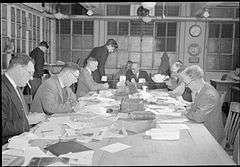Copy boy
A copy boy is a typically young and junior worker on a newspaper. The job involves taking typed stories from one section of a newspaper to another. According to Bruce Guthrie, the former editor-in-chief of the Herald Sun who began work there as a copy boy in 1972:
Reporters typed their stories on slips of butcher's paper...then a copy boy ran the story into the neighbouring subs' [sub-editor's] room, hence the cry of 'copy'. Each slip of the story had about six carbon copies...stapled together and it was the job of the copy boy - or girl - to separate the original and run it to the subs, and then separate the carbons for distribution.[1]

With the advent of new publishing and printing technology the position is now almost extinct, but in the first two decades after World War II, most editors of medium and large newspapers in the US still considered their copy boys indispensable to "getting the paper out." The position was also considered to be an important entry point for aspiring journalists, many of whom got their start as copy boys.[2]
Former copy boys
- Carl Bernstein[3]
- Charles Blackman
- Jimmy Breslin
- James L. Brooks[4]
- Lucien Carr
- John Curtin[5]
- Larry Emdur
- Allen Ginsberg
- Bruce Guthrie[1]
- Michael Ignatieff[6]
- Mark Knopfler[7]
- Ed Koterba[8]
- James J. Montague
- Andy Rooney[9]
- Robert Ruark
- Gary Snyder
- Robert Stone
- Gay Talese
- Hunter S. Thompson
- John Updike[10]
- Jose Antonio Vargas
Fictional copy boys
- Hap Hazard is "the demon copy boy of the Daily Star!" (Ace Comics, 1940-1947)[11][12]
- Jerry Jones is a young copy boy at a New Jersey daily newspaper who works his way up to reporter in Josef Berger's 1938 juvenile novel Copy Boy[13]
- Virgil Ambrose Jeremiah Christopher 'Scoop' Jones, played by Joe E. Brown in the 1937 film Fit for a King, is a copy boy who is given his "big chance" to become a reporter.[14]
- Monty Milde, played by Monty Banks in the 1926 film Atta Boy, is a copy boy on a large New York daily newspaper who is the butt of everyone's pranks but eventually beats the paper's star reporter at solving a kidnapping.[14]
- Jimmy Olsen in the 1938–1940 radio serial of Superman starts out as a copy boy at the Daily Planet before becoming a cub reporter.[15]
- Rudy Rawls is a crime-fighting copy boy on the Daily Herald who "finds out that fists talk louder than words!" (Headline Comics)[16]
References
- Guthrie, Bruce (2010). Man Bites Murdoch, pp. 40; 64–71. Melbourne University Press ISBN 0522858481
- Grimes, Millard B. (1985). The Last Linotype: The Story of Georgia and Its Newspapers Since World War II, p. 221. Mercer University Press. ISBN 0865541906
- Bosman, Julie (14 October 2013). "Carl Bernstein Plans Memoir on His Cub Reporter Days". New York Times
- Harmetz, Aljean (8 April 1984) "Coming to Terms with Success".New York Times
- Renton, Don (4 May 1951). "Have you a PM in your pantry?. The Argus Week-End Magazine
- Ignatieff, Michael (22 November 2012). "The Kind of Journalism Worth Defending". Huffington Post
- Robson Ian (22 February 2015). "Rock star Mark Knopfler was a copy boy on the Chronicle in Newcastle". Evening Chronicle
- Morgret, Ed Koterba (2016) "Introduction". The Essential Ed Koterba, pp. xlix–lii. MCP Books. ISBN 1634139224
- Severo, Richard and Keepnews, Peter (5 November 2011). "Andy Rooney, a Cranky Voice of CBS, Dies at 92". New York Times
- Posten, Bruce R. (29 January 2009). "Before the fame, literary giant John Updike was just a newspaper copy boy". Reading Eagle
- Hap Hazard Comics #1 (Summer 1944).Grand Comics Database
- Nevins, Jess (2013). Encyclopedia of Golden Age Superheroes. High Rock Press. p. 127. ISBN 978-1-61318-023-5.
- Dunbar, Attucks (4 March 1939). "Books". Indianapolis Recorder, p. 10
- Langman, Larry (2009). The Media in the Movies: A Catalog of American Journalism Films, 1900–1996, pp. 28; 91. McFarland. ISBN 147660925X
- Harmin, Jim (2003). Radio Mystery and Adventure and Its Appearances in Film, Television and Other Media, p. 197. McFarland. ISBN 0786485086
- Headline Comics (May-June 1946). Grand Comics Database
Further reading
- Canberra Times (17 July 2008). "Copy Boy became a captain of his industry"